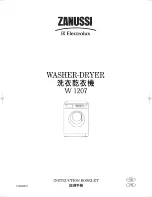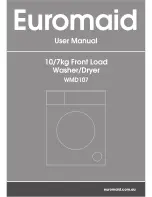
To save energy
Place dishes in the machine immediately after every meal and
wait until the dishwasher is full before washing.
Do not prewash dishes under running water.
For best washing results
Before loading, remove all scraps of food and soak very
heavily soiled pots and pans.
Arrange saucepans, cups and glasses etc. upside-down.
Tilt items with convex or concave surfaces so that the water
drains off easily.
Avoid contact between the dishes as far as possible.
Items not suitable for dishwashers
The following items should not be washed in the dishwasher
(unless they are sold as dishwasher proof):
- Cutlery with wooden or horn handles or glued parts
- bronze cutlery
- saucepans with wooden handles
- aluminium ware
- crystal ware
- leaded glass
- plastic items
- antique or fine decorated china
Certain types of decoration can discolour when washed in a
dishwasher.
Crystal-ware and plastic objects, if not guaranteed dishwasher
proof should be washed by hand.
Certain types of glass can also become opaque after being
washed several times in a dishwasher.
A chemical reaction can occur between silver cutlery and
stainless steel cutlery. As a precaution, do not wash together.
Iron and cast iron objects can rust and stain other items.
Aluminium tends to go black, copper, pewter and brass tend to
stain.
If in doubt check with manufacturer of the item.
When buying new dishes, ensure that they are dishwasher
proof.
Hints and tips
8
Use of detergent
Only use detergents specifically designed for use in
dishwashers.
If using powder detergents proceed as follows:
1. Open the dispenser lid by pulling the catch (D).
2. Add the detergent according to the instructions given in the
"Washing programmes" chart.
As all detergents are not the same, you should also consult
the instructions on the packet.
3. Always close the lid.
4. The programmes with prewash require a small extra
amount of detergent to be poured over the lid of the
dispenser. Follow the recommended quantity of detergent
given in the "Washing programmes" chart.
If using detergent in tablets proceed as follows:
1. For all programmes; place 1 tablet inside the detergent
dispenser.
2. Always close the lid.
3. For all programmes with prewash; place a portion of a
further tablet on the lid of the detergent dispenser.
If detergents in tablet form are used with the "Daily 65°"
programme, it is advisable to put the tablet directly in the
dishwasher and not in the dispenser or in special tablet
containers. This ONLY applies to this programme.
Insufficient quantities of detergent will produce poor
washing results, whereas an excessive amount of
detergent will not improve washing results and is also
wasteful.
Using no more than the correct amount also contributes
to reducing pollution.
Compact detergents with enzymes
In these compact powders the environmentally unfriendly
components have been replaced by natural enzymes and
other more biodegradable substances.
The enzymes deploy their full dirt dissolving power at a
temperature as low as 50°C.
By choosing the BIO/50°C programmes you can therefore
achieve the same cleaning results that would otherwise be
achievable only with 65°C programmes and conventional
detergents.
DE17
DE02


































